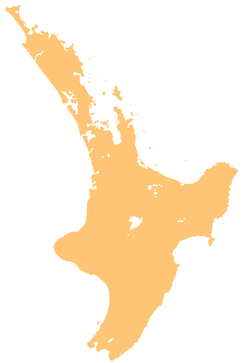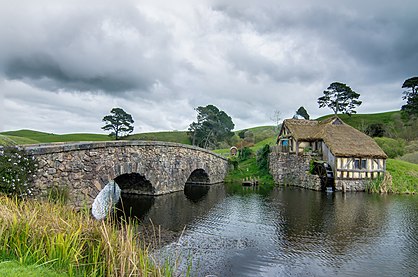Hobbiton Movie Set
Hobbiton | |
|---|---|
Movie Set / Tourist Attraction | |
 A small Waterhouse opposite to the Green Dragon Inn | |
| Coordinates: 37°51′27″S 175°40′47″E / 37.85750°S 175.67972°E | |
| Country | New Zealand |
| Region | Waikato |
| Territorial authority | Matamata-Piako District |
The Hobbiton Movie Set[1] is a significant location used for The Lord of the Rings film trilogy and The Hobbit film trilogy, serving as a stand-in for the town of Hobbiton in the Shire in both trilogies. It is situated on a family-run farm about 8 kilometres (5.0 mi) west of Hinuera and 10 kilometres (6.2 mi) southwest of Matamata, in Waikato, New Zealand, and is now a Tolkien tourism destination, offering a guided tour of the set.
Pre-film set history
The geology of the area is that of the Hinuera Formation, a group of alluvial silts, sands and gravels laid down in the Last Glacial Period.[2] Originally largely marshland, it was transformed in the 19th century by a large-scale drainage scheme and is now fertile agricultural land and a major racehorse breeding area.[3]
The Alexander family moved to the 500-hectare (1,200-acre) property of rolling grassland where the set is located in 1978. Since then it has been a livestock ranch with 13,000 sheep and 300 Angus beef cattle. The main sources of income from farming are mutton, wool and beef.[3][4]
The Lord of the Rings
When Peter Jackson began to look for suitable locations for The Lord of the Rings film series,[5] he first saw the Alexander Farm during an aerial search[4] in 1998[6] and concluded that the area was "like a slice of ancient England".[5] Set Decorator Alan Lee commented that the location's hills "looked as though Hobbits had already begun excavations".[7] Part of the site has a lake with a long arm that could double as a river.[7]

After suitable negotiations with the owners, work commenced in transforming part of the farm into sets for Hobbiton and other parts of J. R. R. Tolkien's Shire in March 1999.[4] The New Zealand Army brought in heavy equipment to make 1.5 kilometres (0.93 mi) of road into the site from the nearest local road and initial ground works. Further work included building the facades for 37 hobbit holes and associated gardens and hedges, a mill and double arch bridge, and erecting a 26-tonne (29-ton) oak above Bag End that was cut down near Matamata and recreated on site, complete with artificial leaves. Thatch on the pub and mill roofs was made from rushes growing on the farm. Generators were installed and water and sewage also had to be considered. Catering was made available for up to 400 cast, crew and visitors per day.[2][4]
Jackson wrote: "I knew Hobbiton needed to be warm, comfortable and feel lived in. By letting the weeds grow through the cracks and establishing hedges and little gardens a year before filming, we ended up with an incredibly real place, not just a film set".[5] Lee commented that "it was satisfying to see that it had taken on something of the look of the Devonshire countryside I'd lived in for the past twenty-five years".[7]
Filming The Hobbit
The original set was not built to last, the hobbit hole facades having been constructed from untreated timber, ply and polystyrene and partially torn down after filming.[8] In 2010, the set was rebuilt in a more permanent fashion for The Hobbit: An Unexpected Journey,[6][9] filming for which began in 2011.[10] Ian McKellen reprised his role as Gandalf the Grey and was joined on the Hobbiton location by Martin Freeman, who remarked that the site "just looked like a place where people lived and where people worked".[6]
Visitor centre
Guided tours of the 5.5 hectares (14 acres) movie set site commenced in 2002[11] and continue to be provided daily. The two-hour excursion is very popular, and advance bookings are recommended.[2][11][12]
Highlights of the tour include Bagshot Row, the Party Tree, and Bilbo's Bag End home. There are now 44 hobbit holes on view[11][13] although it is only possible to enter a few of them, all of which have small, unfinished, earth-walled interiors.[14] (The interior of Bag End was shot in a studio in Wellington).[15] The hobbit holes on site have been designed and built to one of three different scales. In addition to the smallest ones built to the correct size (hobbits are smaller than humans), some are built to a larger scale to make the hobbit actors appear smaller, and some have been constructed in a "dwarf" scale for scenes containing dwarves. Apart from a few exceptions, the colour of the front door indicates the scale, for example hobbit holes with a blue door are built to the correct scale for humans.
Refreshments are available at "The Shires Rest Cafe" prior to or after tours. Breakfast and indeed "Second Breakfast" is served.[16] In 2012 the "Green Dragon" inn (a replica of the Green Dragon that featured in The Lord of the Rings and Hobbit trilogies) was opened on the set.[17] There is now also a store selling merchandise and souvenirs adjacent to the cafe and evening events commenced in 2014. The tours have generally received good reviews.[18][19] In 2013 the set welcomed its 500,000th guest.[11][1]
In December 2023 new holes were opened to the public, which took nine months to complete.[20]
-
Peter Jackson said of the set, "It felt as if you could open the circular green door of Bag End and find Bilbo Baggins inside".[5]
-
Hobbit holes overlooking the lake on the set
-
Hobbiton mill and double-arched bridge
-
Interior of the Green Dragon inn
References
- ^ a b "Home". Hobbiton Movie Set Tours. Retrieved 24 January 2015
- ^ a b c Brodie (2004) p. 33
- ^ a b Brodie (2004) p. 32
- ^ a b c d "About Us" Archived 24 October 2016 at the Wayback Machine. Hobbiton Movie Set Tours. Retrieved 24 January 2015
- ^ a b c d Brodie (2004) Foreword
- ^ a b c New Zealand: Home of Middle-earth. (19 Mar 2013). Go New Zealand. (Available on YouTube).
- ^ a b c Brodie (2004) p. 19
- ^ "Our Story". Hobbiton Movie Set. Retrieved 31 August 2018.
- ^ "The Hobbit Trilogy filming locations". Go New Zealand. Retrieved 25 January 2015
- ^ Trumbore, Dave (20 March 2011). "Production Officially Begins on Peter Jackson's ''The Hobbit; Plus Two New Images and the Official Synopsis". Collider. Retrieved 22 September 2012.
- ^ a b c d "Our Tours" Hobbiton Movie Set Tours. Retrieved 24 January 2015
- ^ "Hobbiton Movie Set Tours" Tourism New Zealand. Retrieved 24 January 2015
- ^ "Hobbiton Express Tour from Auckland". Go New Zealand. Retrieved 24 January 2015
- ^ "FAQ" Archived 20 October 2016 at the Wayback Machine. Hobbiton Movie Set Tours. Retrieved 25 January 2015
- ^ Roberts, Susan (2 October 2014) "A Day at Hobbiton". The Scribbling Scribes. Retrieved 26 January 2015
- ^ "The Shires Rest Cafe" Archived 20 October 2016 at the Wayback Machine. Hobbiton Movie Set Tours. Retrieved 24 January 2015
- ^ Hawes, Rexine; Bain, Mike (13 February 2017). "Hobbiton movie set could continue to attract new generations of tourists". Stuff. Retrieved 24 May 2018.
- ^ Rawlings-Way et al (2008) p. 50
- ^ "A Tolkien fan's paradise - Review of Hobbiton Movie Set, Hinuera, New Zealand". Tripadvisor.
- ^ "An inside look at the new attraction opening at Hobbiton". 1 News. Retrieved 3 December 2023.
Bibliography
- Ian Brodie (2004) The Lord of the Rings Location Guidebook. (Extended Edition). HarperCollins. Auckland.
- Charles Rawlings-Way, Brett Atkinson, Sarah Bennett, Peter Dragicevich and Errol Hunt (2008) Lonely Planet New Zealand. Lonely Planet. Melbourne.



![Peter Jackson said of the set, "It felt as if you could open the circular green door of Bag End and find Bilbo Baggins inside".[5]](http://upload.wikimedia.org/wikipedia/commons/thumb/f/f2/Baggins_residence_%27Bag_End%27_with_party_sign.jpg/416px-Baggins_residence_%27Bag_End%27_with_party_sign.jpg)



